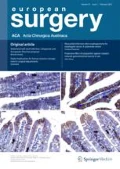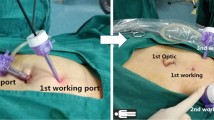Summary
Background
Primary and secondary ventral hernias of the abdominal wall are very common conditions; however, the ideal operative treatment has not been found yet.
Methods
In the traditional open sublay technique, a large trauma to the abdominal wall must be accepted, which carries a high risk of infection, while the laparoscopic intraperitoneal onlay mesh (IPOM) technique is burdened with the need for special and expensive meshes and fixation devices as well. Moreover, the IPOM technique carries a significant risk of bowel injury. In order to avoid the disadvantages of these techniques, we developed an endoscopic technique (endoscopic mini/less open sublay; EMILOS) that allows for complete dissection of the retromuscular space for placement of a huge mesh to reinforce the whole anterior abdominal wall, while performing a 5-cm skin incision only.
Results
From June 2015 to January 2017, a total of 50 patients were operated on using the MILOS concept, nine patients underwent the original MILOS technique, and 41 patients had the EMILOS operation. The operative steps of this novel endoscopic variation, the EMILOS procedure, are described in detail. The average skin incision was 5.1 cm (3–8), and mean operative time was 160 min (90–255). In 38 patients the size of the mesh was 30 × 20 cm, in two patients 30 × 16 cm, and in one patient 15 × 15 cm. The average hospital stay was 3.2 days. The median pain score (VAS) under physical stress (e. g., climbing stairs) was 2.7.
Conclusion
The first results of the EMILOS operation are promising. The technique is standardized, reproducible, cost-effective, and allows one to place a large mesh into the retromuscular position, while avoiding severe trauma to the abdominal wall and the transabdominal route.










Similar content being viewed by others
References
Bittner R, Bingener-Casey J, Dietz U, Fabian M, Ferzli GS, Fortelny RH, Köckerling F, Kukleta J, Leblanc K, Lomanto D, Misra MC, Bansal VK, Morales-Conde S, Ramshaw B, Reinpold W, Rim S, Rohr M, Schrittwieser R, Simon T, Smietanski M, Stechemesser B, Timoney M, Chowbey P. Guidelines for laparoscopic treatment of ventral and incisional abdominal wall (International Endohernia Society (IEHS)) – Part I. Surg Endosc. 2014;28(1):2–29.
Al Chalabi H, Larkin J, Mehigan B, McCormick P. A systematic review of laparoscopic versus open abdominal incisional hernia repair, with meta-analysis of randomized controlled trials. Int J Surg. 2015;20:65–74.
Sauerland S, Walgenbach M, Habermalz B, Seiler CM, Miserez M. Laparoscopic versus open surgical techniques for ventral or incisional hernia repair. Cochrane Database Syst Rev. 2011; . doi:10.1002/14651858.cd007781.pub2.
Arita NA, Nguyen MT, Nguyen DH, Berger RL, Lew DF, Suliburk JT, Askenasy EP, Kao LS, Liang MK. Laparoscopic repair reduces incidence of surgical site infections for all ventral hernias. Surg Endosc. 2015;29(7):1769–80.
Awaiz A, Rahman F, Hossain MB, Yunus RM, Khan S, Memon B, Memon MA. Meta-analysis and systematic review of laparoscopic versus open mesh repair for elective incisional hernia. Hernia. 2015;19(3):449–63.
Reinpold W. Endoskopisch totalextraperitonealer transhernialer Sublay – Bauchwand-Hernienverschluss in Single-Port-Technik. In: Schumpelick V, Arlt G, Conze J, Junge K, editors. Hernien, 5th edn. Stuttgart: Thieme; 2015. pp. 301–4.
Schwarz J, Reinpold W, Bittner R. Endoscopic mini/less open sublay technique (EMILOS)-a new technique for ventral hernia repair. Langenbecks Arch Surg. 2017;402(1):173. doi:10.1007/s00423-016-1522-0.
Misra MC, Kumar S, Bansal VK. Total extraperitoneal (TEP) mesh repair of inguinal hernia in the developing world: comparison of low-cost indigenous balloon dissection versus direct telescopic dissection: a prospective randomized controlled study. Surg Endosc. 2008;22(9):1947–58.
Conze J, Prescher A, Klinge U, Saklak M, Schumpelick V. Pitfalls in retromuscular mesh repair for incisional hernia: the importance of the “fatty triangle”. Hernia. 2004;8(3):255–9.
Köckerling F, Botsinis MD, Rohde C, Reinpold W. Endoscopic-assisted Linea Alba reconstruction plus mesh augmentation for treatment of umbilical and/or epigastric hernias and rectus abdominis diastasis – early results. Front Surg. 2016;3:1–6.
Bellido Luque J, Bellido Luque A, Valdivia J, Suarez Gráu JM, Gomez Menchero J, García Moreno J, Guadalajara Jurado J. Totally endoscopic surgery on diastasis recti associated with midline hernias. The advantages of a minimally invasive approach. Prospective cohort study. Hernia. 2015;19(3):493–501.
Schroeder AD, Debus ES, Schroeder M, Reinpold WM. Laparoscopic transperitoneal sublay mesh repair: a new technique for the cure of ventral and incisional hernias. Surg Endosc. 2013;27(2):648–54.
Costa TN, Abdalla RZ, Santo MA, Tavares RRFM, Abdalla BMZ, Cecconello I. Transabdominal midline reconstruction by minimally invasive surgery: technique and results. Hernia. 2016;20(2):257–65.
Köhler G, Luketina RR, Emmanuel K. Sutured repair of primary small umbilical and epigastric hernias: concomitant rectus diastasis is a significant risk factor for recurrence. World J Surg. 2015;39(1):121–6.
Author information
Authors and Affiliations
Corresponding author
Ethics declarations
Conflict of interest
R. Bittner and J. Schwarz declare that they have no competing interests.
Rights and permissions
About this article
Cite this article
Bittner, R., Schwarz, J. Endoscopic mini/less open sublay operation for treatment of primary and secondary ventral hernias of the abdominal wall. Eur Surg 49, 65–70 (2017). https://doi.org/10.1007/s10353-017-0472-2
Received:
Accepted:
Published:
Issue Date:
DOI: https://doi.org/10.1007/s10353-017-0472-2




